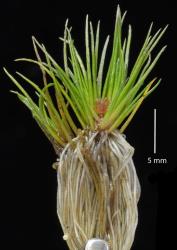- ≡ Hydatella inconspicua (Cheeseman) Cheeseman, Trans. & Proc. Roy. Soc. New Zealand 39: 434 (1907)
Aquatic perennial herb, tufted 10–55 mm in height, from a shortly branching erect rhizome, trichomes present; copious adventitious roots. Apomictic or sexual. Plants in populations often female only, or plants cosexual with unisexual or bisexual reproductive units. Leaf-bases weakly dilated (not sheathing), hyaline, toothed auricles present or absent; leaves spreading, glabrous, 8.0–55 × 0.25–0.6 mm; lamina linear-filiform, adaxially faintly compressed below, terete above, apex rounded with a hydathode. Reproductive units (3.5–)4–5(–7) mm long, on glabrous scapes, 1–5 per plant; involucral bracts 2–4(–7), sometimes dimorphic. Stamens 1–8, anthers 0.8–1.4 mm long, filaments 1–5 mm long (only T. inconspicua subsp. inconspicua); pollination syndrome anemophilous or gravitational autogamy. Carpels (2–)8–25, white to reddish, with multicellular stigmatic hairs of unequal length or reduced to a knobbly capitate head. Fruits 0.39–0.56 × 0.2–0.5 mm, beaked, deciduous from persistent stalks, pericarp thin and membraneous, smooth, indehiscent. Seed faintly reticulate, yellow-brown to red-brown with a darker apical cap (formed by an operculum).
Trithuria inconspicua is morphologically similar to T. filamentosa of Tasmania, its sister species in phylogenetic analyses with an estimated divergence of 0.5 Ma [0–1.1 Ma] (Iles et al. 2012, 2014). They share unique features in the genus such as: perennial life history (Pledge 1974), a fully aquatic habitat (Edgar 1966; Edgar 1970; Wells et al. 1998) and apomixis (Remizowa et al. 2008; Rudall et al. 2009; Smissen et al. 2019). Gruenstaeudl et al. (2017) discovered a difference in length in the plastid genomes between the two species >15 kbp and hypothesised a single expansion in the IR region.
| 1 | Stigmatic hairs approx. 1 mm long (Northland) | T. inconspicua subsp. inconspicua |
| Stigmatic hairs reduced to a capitate head (Otago, Southland) | T. inconspicua subsp. brevistyla |
The minute tufts have narrow, linear leaves with a single mid-vein. The female inflorescence has mostly two or four bracts (sometimes more) that enclose a distinctive cluster of yellow to white or pinkish carpels, each attached to a stalk. Trithuria inconspicua is most similar vegetatively to Eleocharis pusilla if the creeping rhizome of the latter is buried in the substrate and missed in collection, but in that case T. inconspicua can be distinguished from it and species of Isoetes by having non-septate leaves. It differs from species of Centrolepis by having no leaf-sheaths, or if they are present they are very short and weak, whereas species of Centrolepis have a relatively well-defined leaf-sheath.
Disjunct between the South Island (provinces of Southland and Westland) and the North Island (province of North Auckland).
The apparent absence of Trithuria inconspicua sensu lato in Lake Monowai may be due to the artificial raising of the lake level by 2.8 m in 1926 for power generation, since it is present in other nearby lakes. Recent surveys have not relocated Trithuria inconspicua sensu lato previously reported from Lake Moke near Queenstown in Otago and Lake Brunner in Westland. There are no specimens to verify whether these reports are of T. inconspicua subsp. brevistyla.
Aquatic and growing in sediments in the shallows of permanent lakes, both warm-temperate coastal dune lakes (T. inconspicua subsp. inconspicua) and cool-temperate glacial lakes (T. inconspicua subsp brevistyla).
| Category | Number |
|---|---|
| Indigenous (Endemic) | 2 |
| Total | 2 |




